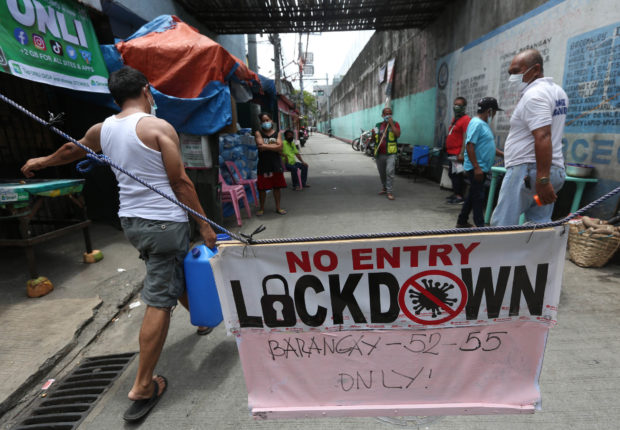Metro Manila curbs eased; local lockdowns seen as stricter

PRECAUTION Barriers have been set up in several villages in Pasay City to prohibit nonresidents from going in and out of these communities as Metro Manila undergoes another round of lockdown to contain the spread of COVID-19. INQUIRER file photo / MARIANNE BERMUDEZ
Stricter localized lockdowns will be implemented even as Metro Manila is placed under what is supposed to be the less restrictive general community quarantine (GCQ), which takes effect on Wednesday until Sept. 30.
But as of Monday, presidential spokesperson Harry Roque said the guidelines for what he called the pilot testing of granular or localized lockdowns were still being finalized.
Nevertheless, Roque said the granular lockdowns, which could cover a house, a street, a barangay, or a district, would be stricter.
He said one feature of the lockdowns would be that authorized persons outside of residence (Apors) would not be allowed to return once they leave until the lockdowns in their areas are lifted.
The government would provide food for the affected households, he said.
Article continues after this advertisementEven before Wednesday’s granular lockdowns take effect, 51 barangays in the capital region are already under that status, according to Philippine National Police Chief Gen. Guillermo Eleazar.
Article continues after this advertisementThe PNP chief called for the public’s cooperation with these lockdowns.
Businesses allowed
Should the pilot testing of the localized lockdowns be successful, the government may do away with quarantine classifications altogether, Roque said.
“There may come a point where the community [quarantine] classifications would no longer be there. But we will pilot it first, so this is not a certainty,” he said.
Despite the granular lockdowns, some businesses would be allowed to operate.
The latest guidelines of the Inter-Agency Task Force for the Management of Emerging Infectious Diseases (IATF) allow businesses to operate at 50 to 100 percent capacity in areas under GCQ.
Restaurants could reopen and religious gatherings would be allowed at 10 percent venue capacity.
All construction activities would also be permitted.
But establishments for entertainment, such as cinemas and karaoke bars, as well as recreational venues and amusement parks would remain closed.
The government will adopt “the framework of 3Cs” to indicate which of these establishments should be avoided because of the risk of COVID-19 transmission. The 3Cs stand for (en)closed spaces, crowded spaces and close-contact settings.
In her press briefing, Health Undersecretary Maria Rosario Vergeire said, “These [guidelines] have to be complied with and [for] establishments that cannot implement this framework, we propose that they should not reopen yet.”
Local governments as well as the Department of Health will decide which areas and establishments will have restricted activity, she said.
Other areas
Meanwhile, the IATF also approved the following quarantine classifications for other parts of the country also from Sept. 8 to 30.
To be under modified enhanced community quarantine, the second strictest level, are the provinces of Apayao, Bataan, Bulacan, Cavite, Rizal, Laguna and Iloilo and the cities of Lucena, Iloilo and Cagayan de Oro.
Areas under GCQ with heightened restrictions are the provinces of Ilocos Sur, Ilocos Norte, Pangasinan, Cagayan, Quezon, Batangas, Antique, Capiz, Cebu, Negros Oriental, Zamboanga del Sur, Misamis Oriental, Davao del Norte, Davao de Oro and Davao Occidental and the cities of Naga, Bacolod, Lapu-Lapu, Davao and Butuan.
Also under GCQ, but without any additional restrictions, are Baguio City, Kalinga, Abra, Benguet, Dagupan City, City of Santiago, Quirino, Isabela, Nueva Vizcaya, Tarlac, Occidental Mindoro, Puerto Princesa, Aklan, Guimaras, Negros Occidental, Cebu City, Mandaue City, Zamboanga Sibugay, Zamboanga City, Zamboanga del Norte, Misamis Occidental, Iligan City, Davao Oriental, Davao del Sur, General Santos City, Sultan Kudarat, Sarangani, North Cotabato, South Cotabato, Agusan del Norte, Agusan del Sur, Dinagat Islands, Surigao del Norte, Surigao del Sur, Cotabato City and Lanao del Sur.
The rest of the country would be under modified general community quarantine.
‘Red list’
Travelers coming from countries to be included in a “red list” being prepared by the government will be barred from entering the country, Roque said.
The list is not yet final but will be guided by new classifications approved by the government’s pandemic managers.
One such guideline is that countries will be considered high risk and placed on the list if the incidence rate for populations greater than 100,000 is more than 500, or if the COVID-19 case count for populations less than 100,000 is also more than 500.
“There are countries that will be covered by a travel ban, the red countries. So let’s make that very clear,” Roque said.
Earlier, the government released a “yellow” list of countries with moderate risk of COVID-19 transmission and a “green” list of countries with low risk of transmission.
Travelers from countries on the yellow list, regardless of vaccination status, must undergo a 14-day quarantine, 10 days in a government facility. They must also undergo an RT-PCR (reverse transcription-polymerase chain reaction) test on the seventh day and be monitored for symptoms.
Countries named in the green list, which the government has released, are American Samoa, Anguilla, Australia, Benin, Burkina Faso, Cameroon, Cayman Islands, Chad, China, Comoros, Republic of the Congo, Djibouti, Equatorial Guinea, Falkland Islands (Malvinas), Gabon, Grenada, Hong Kong (Special Administrative Region of China), Hungary, Mali, Federated States of Micronesia, Montserrat, New Caledonia, New Zealand, Niger, Northern Mariana Islands, Palau, Poland, Saba, Saint Pierre and Miquelon, Sierra Leone, Sint Eustatius, Slovakia and Taiwan.
Travelers from these countries will have a shorter quarantine of seven days in a government facility but will also undergo RT-PCR testing.